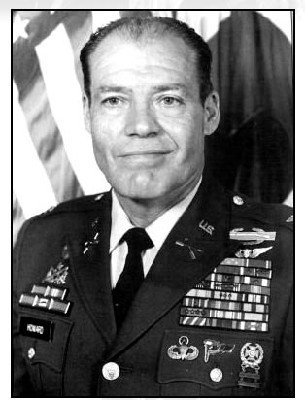
He served with 5th Special Forces Group (Airborne), 1st Special Forces, Military Assistance Command, Vietnam-Studies and Observation Group.

Col. Robert L. Howard, Retired US Army, 70, of Waco and formerly of San Antonio, and who at the time of his death was the most decorated American soldier, passed away Wednesday, December 23, 2009 in Waco.
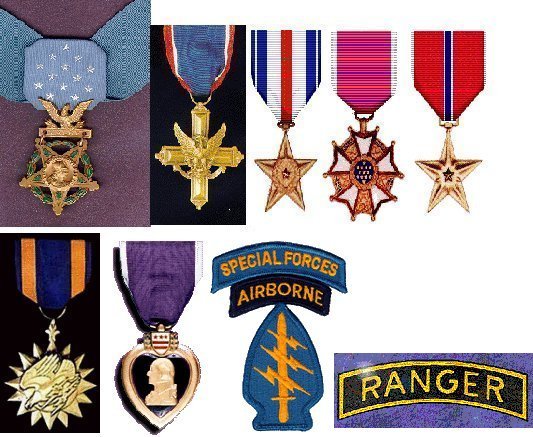
.
Full military honors are pending and will be held at Arlington National Cemetery in Washington, D.C., and will be announced by OakCrest Funeral Home of Waco. His flag draped casket will be in state from 9 a.m. to 4 p.m. Wednesday, December 30 and Thursday, December 31 at the funeral home.
Col. Howard grew up in Opelika, Alabama and enlisted in the US Army in 1956 at the age of 17. He retired as a full Colonel in 1992 after 36 years of service.
During Vietnam, he served in the US Army Special Forces (Green Berets) and spent most of his five tours in the super-secret MACV-SOG.
Col. Howard was nominated three times for the Medal of Honor, his first nomination being downgraded to the DSC.
His second and third nominations were simultaneous for two separate actions and the Medal of Honor was awarded for the first of them and was presented to him by President Richard M. Nixon at the White House in 1971.
The other nomination was downgraded to the Silver Star.
Col. Howard was wounded 14 times in 54 months of combat duty in Vietnam and was awarded 8 Purple Hearts.
Col. Howard is survived by his children, Denicia Howard of Florida, Melissa Gentsch and husband, Asst. Chief of Police Frank Gentsch of Waco, Rosslyn Howard of California and Robert Howard, Jr. and wife, Tori of California; and his grandchildren, Victoria Batey and husband, Luke of Denton, Holley Gentsch of Waco, Trey Howard of California, Isabella Gentsch of Waco and George Harris of Florida.
Robert L. Howard, one of America’s most decorated soldiers. He served five tours in Vietnam and is the only soldier in our nation’s history to be nominated for the Congressional Medal of Honor three times for three separate actions within a thirteen month period. Although it can only be awarded once to an individual, men who served with him said he deserved all three. He received a direct appointment from Master Sergeant to 1st Lieutenant in 1969, and was awarded the Medal of Honor by President Richard M. Nixon at the White House in 1971. His other awards for valor include the Distinguished Service Cross – our nation’s second highest award, the Silver Star – the third highest award, and numerous lesser decorations including eight Purple Hearts. He received his decorations for valor for actions while serving as an NCO (Sergeant First Class).
Robert L. Howard grew up in Opelika, Alabama and enlisted in the U.S. Army in 1956 at age seventeen. He retired as a full Colonel in 1992 after 36 years service. During Vietnam, he served in the U.S. Army Special Forces (Green Berets) and spent most of his five tours in the super-secret MACV-SOG (Military Assistance Command Vietnam Studies and Observations Group) also known as Special Operations Group, which ran classified cross-border operations into Laos, Cambodia, and North Vietnam. These men carried out some of the most daring and dangerous missions ever conducted by the U.S. military. The understrength sixty-man recon company at Kontum in which he served was the Vietnam War’s most highly decorated unit of its size with five Medals of Honor. It was for his actions while serving on a mission to rescue a fellow soldier in Cambodia, that he was submitted for the Medal of Honor the third time for his extraordinary heroism.
Robert L. Howard is said to be our nation’s most decorated soldier from the Vietnam War. He was the last Vietnam Special Forces Medal of Honor recipient still on active duty when he retired on Sept. 29, 1992. His story is told in John Plaster’s excellent book, SOG The Secret Wars of America’s Commandos in Vietnam.
It is important for future generations that we remember our military heroes and the great sacrifices they have made for us in the name of Freedom.
.
Texas Governor Rick Perry issued a statement late Wednesday afternoon in which he said Howard “was the bravest soldier I ever met.”
“His unshakeable commitment to freedom, displayed in countless episodes of battlefield gallantry, lives on in the actions of our military men and women who continue to serve in hostile conditions overseas,” he said.
.
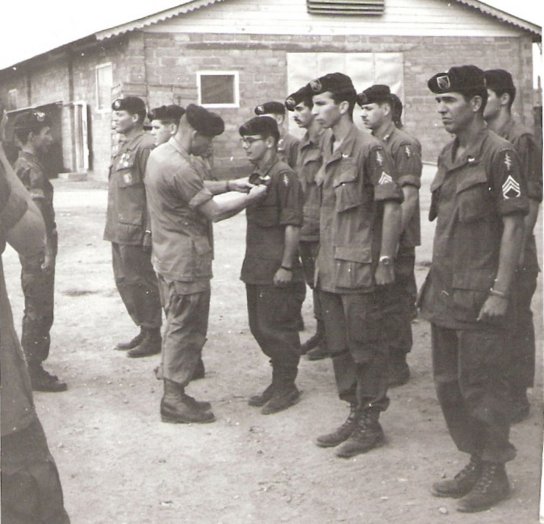
MACV SOG FOB2 CCC – Awards & Decorations formation Dec-Feb 1967-68 – LTC Roy Bahr is presenting LT Ward the CIB, SFC Bob Howard is on left side of photo – 1st man facing left in formation. (Photo courtesy Jim Ringland)
In Vietnam, he served in the U.S. Army Special Forces and spent most of his five tours in the secret Military Assistance Command, Vietnam-Studies and Observation Group, or MACV-SOG, which was an unconventional force whose members were assigned to deep-penetration reconnaissance and interdiction missions.
As a staff sergeant of the highly-classified Military Assistance Command, Vietnam – Studies and Observations Group (MACV-SOG), Howard was recommended for the Medal of Honor on three separate occasions for three individual actions during thirteen months spanning 1967-1968. The first two nominations were downgraded to the award of the Distinguished Service Cross due to the covert nature of the operations in which Howard participated. As a Sergeant First Class of the same organization, he risked his life during a rescue mission in Cambodia on December 30, 1968, while second in command of a platoon-sized Hornet force that was searching for missing American soldier Robert Scherdin, and was finally awarded the Medal of Honor.
While leading a covert SOG platoon-sized mission in southeastern Laos on November 16, 1967, Sergeant First Class Howard carried out actions that led to his being recommended for his nation’s highest honor. While the main body destroyed an enemy cache, Howard’s team came upon four North Vietnamese Army soldiers, whom he shot. The team was then pinned down by heavy machine gun fire. Howard first eliminated a sniper and then charged the machine gun position, killing its occupants. When a second machine gun opened up, he crawled forward to within point-blank range and threw a hand grenade, disabling that gun.
When more of the North Vietnamese took over the same gun, Howard stood in the open and fired a light anti-tank weapon, knocking it out once again. The team was then successfully extracted by helicopter. Although recommended for the Medal of Honor, Howard’s award was downgraded to the Distinguished Service Cross. This would be the first of three recommendations within 13 months for the Medal of Honor for Robert Howard.
In mid-November Howard accompanied an FOB-2 Hatchet Platoon into Laos. After four days in the area, on November 19, 1968, the force was ambushed by Vietnamese troops, including a Soviet-built PT-76 tank. Braving intense fire, Howard crept forward and knocked out the PT-76 with an anti-tank rocket. After a medivac helicopter was shot down, Howard, already wounded, charged forward 300 yards through North Vietnamese fire to lead the two pilots and a wounded door gunner to safety. He was again wounded, this time by 14 pieces of shrapnel, but all that this seemed to do was aggravate him.
He charged the Vietnamese, killed two and dragged back a third as a prisoner. North Vietnamese anti-aircraft fire halted the extraction of the platoon until the following morning, when Howard, already perforated multiple times, moved forward and silenced a 37 mm anti-aircraft gun, allowing the extraction to be completed. For the second time, Howard was recommended for the Medal of Honor, but his award was again downgraded to a Distinguished Service Cross.
This series of events illustrates the difficulties faced when special operations personnel exhibited extraordinary bravery in denied areas. Recommendations for decorations always stipulated the location and circumstances of the action, and since the award of such a high decoration became public knowledge, the citation would have to be changed to place the action within territorial South Vietnam. The U.S. Congress and President were loath to create any sense of falsehood about the actions of the nation’s most highly decorated military personnel, so, in many instances, awards were downgraded to keep the recipient out of the limelight.
On December 30, 1968 Howard was serving as a member of a 40-man Bright Light rescue mission into northeastern Cambodia. The unit was in search of MACSOG Private First Class Robert Scherdin, who had been separated from his recon team. Bypassing a North Vietnamese Army company, Howard was leading his men up a hill when he and Lieutenant Jim Jerson were wounded by a land mine. While administering first aid to Jerson, a bullet struck one of the wounded man’s ammunition pouches, detonating several magazines. His fingers in shreds, Howard was dragging Jerson off the hill when he was shot in the foot.
The remaining 20 men were organized by Howard, who administered first aid, directed their fire, and encouraged them to resist. After three and one-half hours under attack, Howard prepared for a fight to the death. The team was saved from that fate, however, when an emergency night extraction took them off without any further casualties. As badly wounded as he was, Howard was the last man to board a helicopter. After his third recommendation in 13 months, Robert Howard was finally awarded a well-deserved Medal of Honor.
Perhaps no man represented the quandary of the political and moral dilemma of the Vietnam War in the heart and mind of America better than Howard. He had become arguably the most highly decorated serviceman in American military history, yet few of his countrymen even knew who he was. Unlike Alvin York or Audie Murphy before him, Howard was not touted as a national hero by the media, he was given no ticker tape parade, and no Hollywood movie was made depicting his extraordinary exploits. Of course, none of this bothered the quiet, unassuming Howard. He remained in the Army and retired as a full Colonel, after 36 years of active service, in September 1992.
It is believed by some historians that Howard is the most highly-decorated living American soldier in history. His residence was in Texas and he spent much of his free time working with veterans at the time of his death. He also took periodic trips to Iraq to visit active duty troops.
.
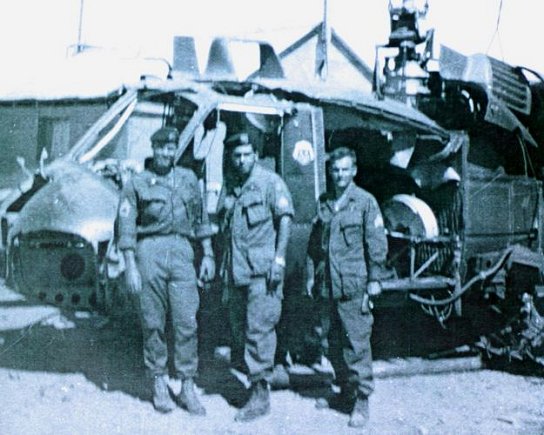
SFC Robert Howard (at left) standing in front of a badly shot up huey – Dak To 1968
The President of the United States in the name of The Congress takes pride in presenting the MEDAL OF HONOR to
FIRST LIEUTENANT
ROBERT L. HOWARD
UNITED STATES ARMY
for service as set forth in the following CITATION:
For conspicuous gallantry and intrepidity in action at the risk of his life above and beyond the call of duty. 1st Lt. Howard (then SFC), distinguished himself while serving as platoon sergeant of an American-Vietnamese platoon which was on a mission to rescue a missing American soldier in enemy controlled territory in the Republic of Vietnam.
The platoon had left its helicopter landing zone and was moving out on its mission when it was attacked by an estimated 2-company force. During the initial engagement, 1st Lt. Howard was wounded and his weapon destroyed by a grenade explosion. 1st Lt. Howard saw his platoon leader had been wounded seriously and was exposed to fire. Although unable to walk, and weaponless, 1st Lt. Howard unhesitatingly crawled through a hail of fire to retrieve his wounded leader. As 1st Lt. Howard was administering first aid and removing the officer’s equipment, an enemy bullet struck 1 of the ammunition pouches on the lieutenant’s belt, detonating several magazines of ammunition. 1st Lt. Howard momentarily sought cover and then realizing that he must rejoin the platoon, which had been disorganized by the enemy attack, he again began dragging the seriously wounded officer toward the platoon area.
Through his outstanding example of indomitable courage and bravery, 1st Lt. Howard was able to rally the platoon into an organized defense force. With complete disregard for his safety, 1st Lt. Howard crawled from position to position, administering first aid to the wounded, giving encouragement to the defenders and directing their fire on the encircling enemy. For 3 1/2 hours 1st Lt. Howard’s small force and supporting aircraft successfully repulsed enemy attacks and finally were in sufficient control to permit the landing of rescue helicopters. 1st Lt. Howard personally supervised the loading of his men and did not leave the bullet-swept landing zone until all were aboard safely.
1st Lt. Howard’s gallantry in action, his complete devotion to the welfare of his men at the risk of his life were in keeping with the highest traditions of the military service and reflect great credit on himself, his unit, and the U.S. Army.
.
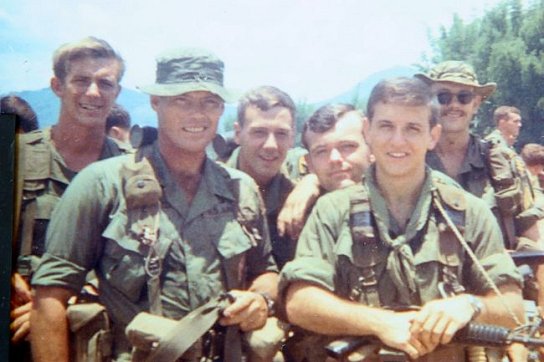
SFC Robert Howard (front left) in Vietnam with some of the guys – MACVSOG (CCC). SGT Chuck Erickson (RT Colorado) is standing behind at far left. Erickson was later on the Son Tay Raid “Blueboy Element” chopper with Dick Meadows. (Photo courtesy John Plaster)
The President of the United States of America, authorized by Act of Congress, July 9, 1918 (amended by act of July 25, 1963), takes pleasure in presenting the Distinguished Service Cross to Sergeant First Class Robert Lewis Howard (ASN: RA-14628152), United States Army, for extraordinary heroism in connection with military operations involving conflict with an armed hostile force in the Republic of Vietnam, while serving with Command and Control (Central), 5th Special Forces Group (Airborne), 1st Special Forces.
Sergeant First Class Howard distinguished himself by exceptionally valorous actions on 21 November 1967, as Special Forces Advisor to a joint American and Vietnamese reconnaissance patrol conducting a search mission near the Laotian border.
His patrol discovered a huge rice and ammunition cache surrounded by an enemy bunker complex. Sergeant Howard led a small team to provide security while the remainder of the unit began to destroy the stored supplies. His team encountered four North Vietnamese Army soldiers, and Sergeant Howard killed them with a fierce burst of rifle fire.
He and his men were immediately pinned down by a murderous curtain of fire which erupted from a nearby enemy machine gun position. With complete disregard for his safety, Sergeant Howard crawled toward the emplacement and killed a North Vietnamese sniper who was firing at him as he maneuvered. He then charged the bunker, eliminating its occupants with rifle fire. A second machine gun position unleashed a savage barrage.
Sergeant Howard moved his troops to a covered location and directed an air strike against the fortified bunker. While assessing the bomb damage, Sergeant Howard was fired upon by North Vietnamese soldiers in the bunker who had survived the blasts. Pinned down directly outside the strongpoint with a blazing machine gun barrel only six inches above his head, he threw a hand grenade into the aperture of the emplacement, killing the gunners and temporarily silencing the weapon. He then dashed to his team’s location and secured a light anti-tank weapon. As the enemy machine gun resumed firing, Sergeant Howard stood up amid a withering hail of bullets, fired his weapon, and completely demolished the position.
His fearless and determined actions in close combat enabled the remainder of the patrol to destroy the enemy cache. Sergeant First Class Howard’s extraordinary heroism and devotion to duty were in keeping with the highest traditions of the military service and reflect great credit upon himself, his unit, and the United States Army.
Service: Army
Rank: Sergeant First Class
Headquarters, U.S. Army, Vietnam, General Orders No. 2018 (May 2, 1968)
.
The President of the United States of America, authorized by Act of Congress, July 9, 1918, takes pleasure in presenting the Silver Star to Sergeant First Class Robert Lewis Howard (ASN: RA-14628152), United States Army, for gallantry in action while engaged in military operations involving conflict with an armed hostile force in the Republic of Vietnam, while serving with Headquarters and Headquarters Company, 5th Special Forces Group (Airborne), 1st Special Forces.
Sergeant First Class Howard distinguished himself by exceptionally valorous actions from 12 to 20 November 1968, during an operation deep within enemy-held territory. As his platoon was being inserted into the area, it came under heavy fie from all directions.
Sergeant Howard leaped from his helicopter before it touched down and began to return fire, providing protection for his men while they dismounted and moved safely off the landing zone. Seeing two enemy soldiers in a wood line, he charged their position and killed them both. When the unit was attacked by a company-size force on the night of 16 November, he went to each platoon member, encouraging them and directing their fire while completely exposing himself to the communist barrage.
Two days later while Sergeant Howard was leading the point element, the platoon was ambushed by an estimated two North Vietnamese Army companies. He skillfully maneuvered his men so that the enemy was caught in a deadly crossfire and the ambush was broken.
The following day, Sergeant Howard had again taken the point element when he observed an estimated battalion-size ambush. Although wounded in the initial exchange of fire, he exposed himself to the aggressors to place effective fire on them and enable his platoon to take cover. Moving from position to position, he administered first aid to the wounded and set up a landing zone so that they could be evacuated.
As the first ambulance helicopter came in, it was struck by hostile machine gun fire and burst into flames. Sergeant Howard, although wounded a second time, ran one hundred and fifty meters to where the ship had crashed and rescued a trapped pilot from the blazing wreckage. Once the entire crew was free from the aircraft, he led them back to the platoon while providing covering fire.
Three hours later another helicopter succeeded in landing and the casualties were evacuated, but Sergeant Howard refused to leave. The next morning, he saw three North Vietnamese soldiers maneuvering towards his element and immediately opened fire, killing them.
Service: Army
Rank: Sergeant First Class
Headquarters, U.S. Army, Vietnam, General Orders No. 371 (February 3, 1969)
.
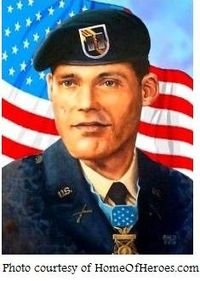
Awards and decorations
Medal of Honor
Distinguished Service Cross (with one oak leaf cluster)
Silver Star
Defense Superior Service Medal
Legion of Merit (with three oak leaf clusters)
Bronze Star (with three oak leaf clusters and “V” device)
Purple Heart (with a silver and two bronze oak leaf clusters)
Meritorious Service Medal (with two oak leaf clusters)
Air Medal (with “V” Device and numeral 3. One award for heroism and two for aerial achievement)
Joint Service Commendation
Army Commendation Medal (with “V” device and one each silver and bronze oak leaf clusters. 4 awards for valor and 3 for achievement)
Joint Service Achievement
Army Achievement
Good Conduct Medal, 4 Good Conduct Loops (4 awards)
National Defense Service Medal
Armed Forces Reserve Medal
Vietnam Service Medal
NCO Professional Development Ribbon with 2 device
Army Overseas Ribbon
Army Service Ribbon
Armed Forces Expeditionary Medal, w/3 Service stars (3 awards)
Army Presidential Unit Citation, 1st Oak Leaf Cluster
Presidential Unit Citation (United States) 2001, Studies and Observations Group
Navy Unit Commendation
Army Meritorious Unit Citation
Foreign decorations
Vietnam Campaign Medal with 60 device
Vietnamese Cross of Gallantry with Gold Star (Corps citation)
Vietnamese Cross of Gallantry with Silver Star (Division citation)
Vietnamese Cross of Gallantry with Bronze Star (Regiment or Brigade citation)
Vietnam Armed Forces Honor Medal 2nd Award
Vietnam Wound Medal
Vietnam Civil Actions Medal 2nd Award
Vietnam Cross of Gallantry Unit Citation with Palm, 1st Oak Leaf Cluster (Unit citation)
Republic of Korea Order of National Security Merit (Samil Medal)
Badges, qualifications and tabs
Ranger Tab
Special Forces Tab
Combat Infantryman Badge
Aircrew Badge
Master Parachutist Badge
Pathfinder Badge
Air Assault Badge
Expert Infantryman’s Badge
Vietnamese Ranger Badge
Vietnamese Master Parachute Badge
Thai Master Parachute Wings
Korean Master Parachute Badge
Thai Balloonist Badge
French Parachutist Badge
.
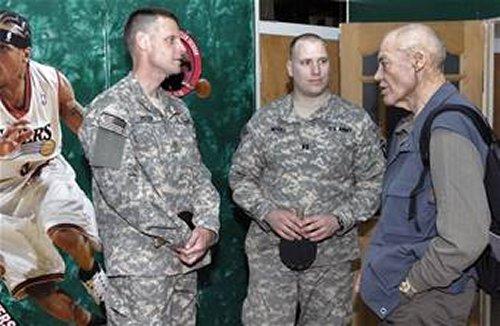
“I spent 37 years in the military, Korea and Vietnam. I’ve been fighting a war all my life,” he said. “I’m fortunate to have served with Americans like you. In your heart, you love why you wear that uniform.”
He also had advice for some of today’s Airmen, Soldiers, Sailors and Marines during a small meet and greet session held in the chapel Saturday.
“Do the job the best you can and don’t ask for help if you don’t plan to use the help,” Colonel Howard said.
Medal of Honor recipient retired Army Col. Robert L. Howard visits with Soilders March 15, 2009 who are transiting through Manas Air Base, Kyrgyzstan.
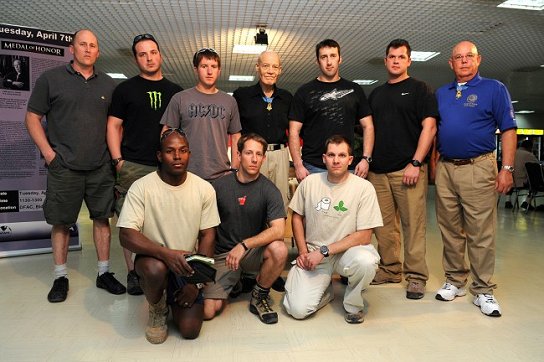
Soldiers of the Army Special Forces Command, 5th Special Forces Group, pose for a photograph with Congressional Medal of Honor recipients at Camp As Sayliyah, Qatar, April 7, 2009.
.

Wild Thing’s comment………..
It has always been an honor for me to get to know our Veterans and today to be able to post about Col. Robert L. Howard is also truly such an honor. I never met him and had never heard of him until Tom sent me this. Our country has been so blessed to have such men in our midst.
Rest in peace Col. Robert L. Howard and thank you.
 ….Thank you Tom for sending this to me.
….Thank you Tom for sending this to me.
Tom
US Army Aviation
Vietnam 1966-68
US Army Special Forces
1970-72
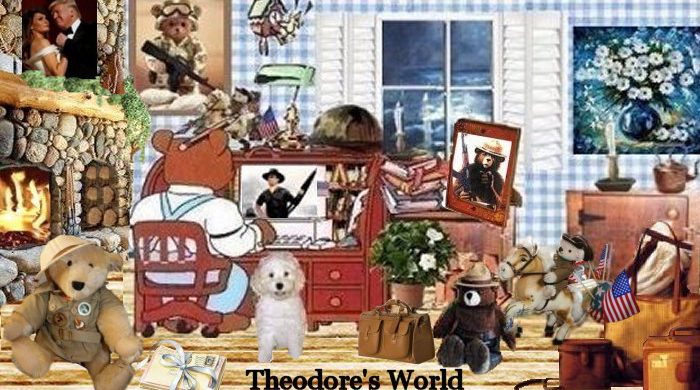
Certainly a great man to be well remembered for years to come. What he did was exemplary in all respects. He did his duties well and to the best of his abilities. This has made him a hero in so many ways. God bless him and his family. He has earned his reward in Heaven and our Lord has told him, “Well done, welcome home son.”
It’s comforting to know that we have thousands of men and women who are carrying on in the great tradition of Col Howard.
Col Bob Howard lived his military life to his fullest. His concern for fellow soldiers was as great in 2009 as it was in 1967. Howard’s valor was not a solo act. Other soldiers were with him when he earned his medals. He just had that extra spark that took him well above and beyond what other brave Americans were also doing. Howard performed these acts of great valor over a five year period. He was not a flash in the pan.
Eternal rest be granted unto him O Lord and let the perpetual light shine upon him. May he rest in peace. Amen. God bless our heroes.
It is a sad day, we don’t have many like him around anymore.
A fine tribute to a great patriotic American. Thank you Chrissie!
Yeah another one is gone. Like the WW-2 generation Vietnam Veterans are starting to disappear too. We must leave a legacy so that someone will remember what we did there. It can not be forgotten it must not be forgotten.
We lost another brother, God Bless him and his family. Semper Fi, Colonel Howard.
In the words of Ronald Reagan, “Where do we find such men?”
Thank you all so much for your comments. It is very special to know all of you, people that
truly understand the sacrifices our Veterans
made.
In the words of Ronald Regan, “Where do we find such men?”
And Happy New Year to you, Chrissie, Nick and all the regular posters.
Oh. And you “irregular” posters, too.
HE WAS A TRUE HERO AND I WISH I COULD HAVE HAD THE OPPERTUNITY OF MEETING HIM PERSONALLY AND SHKING HIS HAND.
ED BASTON
SCOTTSDALE, ARIZONA